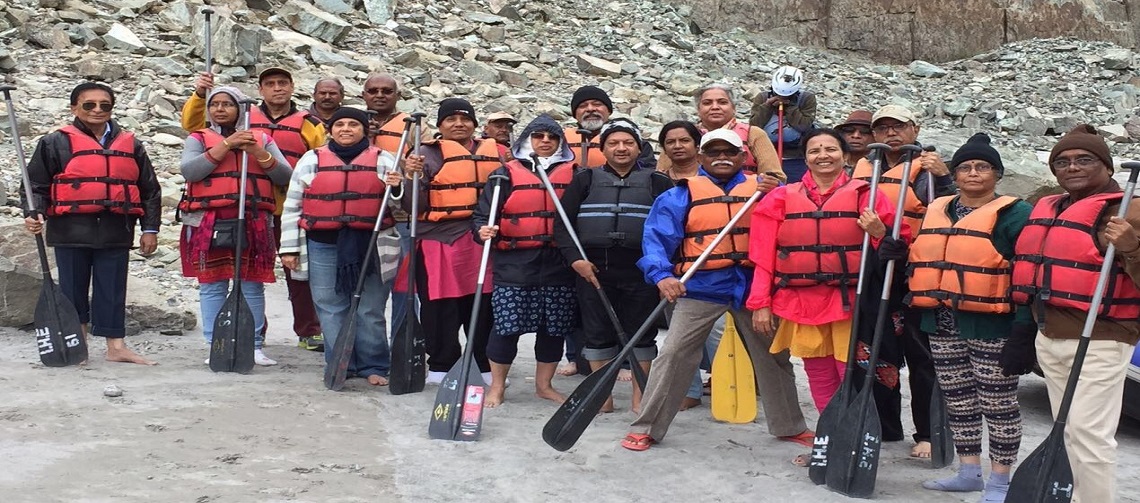Senior citizen travel clubs offer a unique blend of adventure, companionship, and convenience for older adults. These clubs cater to diverse interests and budgets, providing curated travel experiences that address the specific needs and preferences of their members. From luxurious cruises to budget-friendly backpacking adventures, there’s a senior travel club to suit every taste and travel style, ensuring a safe, enjoyable, and enriching experience for all participants.
This exploration delves into the various types of senior citizen travel clubs, examining their membership benefits, logistical considerations, financial aspects, social opportunities, and safety protocols. We will also consider the importance of accessibility and inclusivity within these clubs, ensuring that all senior citizens can enjoy the benefits of travel regardless of their physical limitations or financial resources.
Types of Senior Citizen Travel Clubs
Choosing the right senior citizen travel club can significantly enhance your travel experience, ensuring a comfortable and enjoyable journey tailored to your preferences and needs. Different clubs cater to diverse travel styles, budgets, and interests, offering a range of benefits and experiences. Understanding these variations is crucial in selecting the perfect fit.
Categorization of Senior Travel Clubs by Travel Style
Senior travel clubs can be broadly categorized based on their focus on specific travel styles. These styles dictate the types of activities, accommodations, and overall experience offered to members.
| Club Type | Membership Benefits | Target Age Range | Interests Catered To |
|---|---|---|---|
| Luxury Travel Clubs | High-end accommodations (five-star hotels, luxury cruises), exclusive excursions, personalized service, gourmet dining, private transportation. | 60+ (often caters to affluent retirees) | Fine dining, cultural experiences, relaxation, historical sites, upscale shopping. |
| Adventure Travel Clubs | Active itineraries (hiking, biking, kayaking), visits to national parks and less-visited destinations, opportunities for wildlife viewing, potentially challenging physical activities. | 55-75 (generally attracts those with a higher level of physical fitness) | Outdoor activities, exploration, wildlife, photography, challenging physical pursuits. |
| Budget-Friendly Travel Clubs | Affordable accommodations (hostels, guesthouses, budget hotels), group discounts, shared transportation, focus on value-for-money experiences. | 50+ (appeals to retirees on a fixed income or those seeking budget-conscious travel) | Exploring different cultures, budget travel, social interaction, meeting new people. |
| Cultural & Historical Travel Clubs | Visits to museums, historical sites, cultural events, guided tours by experts, opportunities to learn about local history and traditions. | 60+ (often attracts those interested in learning and experiencing different cultures) | History, art, architecture, music, local customs, learning about different cultures. |
| Cruise-Focused Travel Clubs | Discounted cruise packages, onboard activities and entertainment, shore excursions, opportunities to socialize with fellow travelers. | 55+ (appeals to those who enjoy relaxing vacations and exploring different ports of call) | Relaxation, socializing, exploring different ports of call, onboard entertainment. |
Comparison of Age Ranges and Interests
The age ranges and interests catered to by different senior travel clubs significantly vary depending on the club’s focus. Luxury clubs often attract older, more affluent retirees interested in high-end experiences, while adventure clubs appeal to a younger demographic with a higher level of physical fitness. Budget-friendly clubs are inclusive of a wider age range, targeting those prioritizing affordability. Clubs focused on specific interests, such as culture or cruises, attract members with shared passions. These variations allow individuals to find a club that perfectly aligns with their age, budget, and travel preferences.
Planning & Logistics for Senior Travel
Planning a trip for senior citizens requires careful consideration of various factors to ensure a safe, enjoyable, and memorable experience. This goes beyond simply booking flights and hotels; it necessitates a proactive approach to accessibility, health management, and overall comfort. Thorough planning minimizes potential stress and maximizes the opportunity for enriching travel experiences.
Accessibility Considerations for Senior Travel
Accessibility is paramount when planning trips for seniors. This includes ensuring easy navigation at airports, hotels, and tourist destinations. Consider choosing accommodations with elevators, ramps, and accessible bathrooms. Pre-booking wheelchair assistance at airports and researching the accessibility of planned attractions is crucial. Opt for transportation options with ample space and easy boarding, such as larger taxis or accessible tour buses. Researching the accessibility of planned attractions beforehand helps avoid disappointment and ensures a smooth travel experience. Many museums and historical sites now offer wheelchair rentals and accessible routes.
Health Considerations and Medical Planning for Senior Travelers
Planning for potential health issues is a critical aspect of senior travel. Consult your doctor well in advance of the trip to discuss any necessary vaccinations, medications, or precautions. Pack a comprehensive first-aid kit including any personal medications, and carry a list of current medications with dosages and contact information for your doctor. Travel insurance that covers medical emergencies and evacuations is essential. Consider purchasing travel insurance with provisions for medical evacuation or repatriation, which is particularly important for international travel. It is advisable to carry a copy of your medical records and any relevant health information.
Sample 7-Day European Tour Itinerary for Seniors
This itinerary focuses on manageable pacing and accessibility, prioritizing comfort and minimizing strenuous activities.
| Day | Location | Activities | Accessibility Notes |
|---|---|---|---|
| 1 | Paris, France | Arrival, check into hotel near major attractions. Gentle walking tour of the Marais district, including a visit to a park. | Hotel with elevator, accessible transportation options available. Marais is relatively flat and walkable. |
| 2 | Paris, France | Guided tour of the Louvre Museum (focus on key highlights), Seine River cruise. | Wheelchair rentals available at the Louvre. Accessible river cruises are readily available. |
| 3 | Amsterdam, Netherlands | Train travel to Amsterdam. Canal cruise, visit Anne Frank House (pre-booked tickets recommended due to high demand). | Train travel is accessible. Canal cruises offer accessible options. Anne Frank House has limited accessibility, pre-booking essential to check. |
| 4 | Amsterdam, Netherlands | Visit the Rijksmuseum (focus on key highlights), explore Vondelpark. | Wheelchair rentals available at the Rijksmuseum. Vondelpark is largely flat and accessible. |
| 5 | Bruges, Belgium | Train travel to Bruges. Walking tour of the historic city center (consider a horse-drawn carriage for longer distances). | Train travel is accessible. Cobblestone streets may be challenging for some. Horse-drawn carriages provide a comfortable alternative. |
| 6 | Bruges, Belgium | Boat tour of the canals, free time for shopping and exploring. | Accessible boat tours are available. |
| 7 | Departure | Travel to the airport for departure. | Accessible transportation options to the airport should be pre-arranged. |
Senior Traveler’s Group Trip Checklist
Preparing a comprehensive checklist ensures a smooth and stress-free journey. This checklist covers essential health documents, travel insurance details, and necessary packing items.
- Health Documents: Copies of passport, visa (if required), driver’s license, health insurance card, medical records (including medication list and allergies), doctor’s contact information.
- Travel Insurance: Policy details, including emergency contact information.
- Medications: Sufficient supply of all prescription and over-the-counter medications, in original containers with labels.
- Packing Essentials: Comfortable walking shoes, appropriate clothing for varying weather conditions, lightweight luggage, toiletries, personal care items, any assistive devices.
- Emergency Contacts: List of emergency contacts, including family, friends, and local emergency services.
Managing Medications and Medical Emergencies During Senior Travel
Carry all medications in their original containers, clearly labeled with your name and dosage information. Pack a sufficient supply for the duration of the trip, plus a few extra days’ worth in case of delays. Inform your travel companions and tour guides of any allergies or medical conditions. Know the location of the nearest medical facilities and pharmacies at your destination. In case of a medical emergency, immediately contact your travel insurance provider and follow their instructions. It is advisable to familiarize yourself with local emergency numbers.
Financial Aspects of Senior Travel Clubs
Understanding the financial implications is crucial before joining a senior travel club. Membership fees, trip costs, and potential savings all need careful consideration to ensure a financially responsible and enjoyable travel experience. This section will outline the various financial aspects involved, enabling informed decision-making.
Membership Fees and Associated Costs
Senior travel clubs offer diverse membership structures with varying fees. Some clubs operate on an annual membership fee, providing access to discounted travel packages and exclusive member benefits. Others may charge a one-time registration fee alongside per-trip costs. Additional fees might include booking fees, insurance premiums, or optional add-ons like travel insurance or airport transfers. The specific costs depend on the club’s structure and the level of service offered. For example, a premium membership might include access to luxury accommodations and concierge services, resulting in higher fees compared to a basic membership. It’s essential to thoroughly review the club’s fee schedule before committing to membership.
Comparison of Membership Tiers
Many senior travel clubs offer tiered membership options, each with varying benefits and price points. A basic membership might offer access to discounted travel packages and member-only deals, while a premium membership could include features such as complimentary upgrades, priority booking, and personalized travel assistance. The value proposition of each tier depends on individual travel preferences and budget constraints. For instance, a frequent traveler who prioritizes convenience and luxury might find the premium membership worthwhile, whereas a less frequent traveler might find a basic membership sufficient. Direct comparison of features and costs across different tiers is vital for making an informed decision.
Financial Benefits and Drawbacks of Using a Travel Club
Utilizing a senior travel club can offer several financial advantages. Group discounts on flights, accommodations, and tours can significantly reduce travel costs. Access to exclusive deals and promotions can further enhance savings. However, travel clubs may not always offer the lowest prices, and the convenience of pre-packaged itineraries might come at a premium. Independent travel planning, while requiring more effort, can sometimes lead to lower overall costs if meticulously researched and booked. Therefore, comparing the total cost of a trip planned independently versus through a travel club is crucial. A detailed budget breakdown for both options should be considered before making a decision.
Sample Budget Breakdown for a 10-Day Trip for a Senior Couple
Let’s consider a hypothetical 10-day trip for a senior couple using a travel club. This example uses estimated figures and should be adjusted based on the specific club, destination, and travel style.
| Expense Category | Estimated Cost |
|---|---|
| Annual Membership Fee (Club A) | $200 |
| 10-Day Trip Package (flights, accommodation, some excursions) | $4000 |
| Meals (estimated $100/day for two) | $1000 |
| Incidentals (souvenirs, tips, etc.) | $500 |
| Travel Insurance | $100 |
| Total Estimated Cost | $5800 |
Note: This is a sample budget. Actual costs may vary significantly depending on the chosen destination, travel style, and the specific travel club’s offerings. Always request a detailed breakdown of all costs from the travel club before committing.
Safety and Security Considerations
Safe and secure travel is paramount for senior citizen travel clubs. Reputable organizations prioritize member well-being by implementing comprehensive safety protocols and readily available support systems. These measures address potential risks and provide peace of mind for both members and their families.
Safety Protocols and Measures Implemented by Reputable Senior Travel Clubs
Reputable senior travel clubs employ a multi-layered approach to safety. This includes pre-trip briefings detailing local customs, emergency procedures, and contact information. Thorough vetting of hotels, transportation providers, and tour guides ensures adherence to safety standards and a commitment to responsible tourism practices. Many clubs utilize 24/7 emergency hotlines staffed by trained professionals who can assist with medical emergencies, lost luggage, or other unforeseen issues. Furthermore, trip itineraries are designed to minimize risks, considering factors like terrain, weather conditions, and potential health concerns. Clubs may also provide travel insurance that covers medical emergencies, trip cancellations, and lost belongings.
Emergency Procedures and Support Systems
Emergency procedures vary depending on the specific club and the nature of the emergency. However, most clubs have established protocols for contacting emergency services, arranging medical evacuations, and providing support to affected members. This often includes a dedicated emergency contact person who is available around the clock. Members typically receive detailed instructions on how to access emergency services in their destination and are provided with contact information for local emergency services and the club’s emergency response team. In the event of a medical emergency, the club may arrange for transportation to the nearest hospital, liaison with medical professionals, and assist with insurance claims. For less urgent situations, such as lost luggage or missed connections, the club will provide guidance and assistance in resolving the issue.
Strategies for Ensuring Safety and Security During Excursions and Group Activities
Group cohesion and clear communication are key to ensuring safety during excursions. Trained group leaders or guides maintain close supervision, regularly checking in with members and addressing any concerns. Detailed itineraries are provided in advance, outlining meeting points, schedules, and emergency procedures. In situations where members have mobility challenges, appropriate accommodations are made, such as providing assistance with walking or arranging accessible transportation. During excursions involving outdoor activities, safety equipment such as helmets or life vests might be provided and their proper use explained. Pre-trip health assessments may be encouraged or required, allowing for appropriate planning and mitigation of potential risks.
Recommendations for Seniors Traveling Alone or with Limited Mobility
Seniors traveling alone or with limited mobility should take extra precautions to ensure their safety and security.
- Share itinerary details with family or friends and check in regularly.
- Keep important documents, including medical information and emergency contacts, readily accessible.
- Consider purchasing travel insurance that covers medical emergencies and trip interruptions.
- Use reputable transportation services and avoid traveling alone at night or in unsafe areas.
- Inform hotel staff of any mobility limitations and request assistance as needed.
- Pack essential medications and keep them readily accessible.
- Wear a medical alert bracelet or necklace, especially if traveling alone.
- Be aware of your surroundings and avoid displaying large amounts of cash or expensive jewelry.
- Learn basic phrases in the local language to facilitate communication in emergencies.
- Carry a fully charged mobile phone and consider investing in a personal safety device.
Accessibility and Inclusivity in Senior Travel
Senior travel clubs recognize the diverse needs and abilities of their members, striving to create inclusive experiences that cater to everyone, regardless of physical limitations. A key element of this is ensuring accessibility in all aspects of travel, from booking and transportation to accommodations and activities. This commitment to inclusivity allows seniors of all abilities to enjoy the enriching benefits of travel and social interaction.
Accessibility Features Offered by Senior Travel Clubs
Travel clubs actively work to make travel accessible to seniors with disabilities or mobility challenges. This involves offering a range of options and accommodations to ensure a comfortable and enjoyable experience for all members. The following table details some key accessibility features commonly offered:
| Feature | Description | Availability | Examples |
|---|---|---|---|
| Wheelchair Accessibility | Provision of wheelchair-accessible transportation, accommodations, and activity sites. | Varies by club and trip; often requires advance notice. | Wheelchair-accessible buses and vans for transportation; hotels with ramps, elevators, and accessible rooms; tours of sites with wheelchair ramps and elevators. |
| Accessible Transportation | Options for transportation that accommodate mobility devices and other special needs. | Generally available, but specific options may require pre-booking. | Wheelchair-accessible taxis or ride-sharing services; accessible airport transfers; train travel with designated accessible carriages. |
| Accessible Accommodations | Hotels and other lodging options with features designed for accessibility. | Often requires pre-booking and may involve a higher cost. | Rooms with roll-in showers, grab bars, and lowered countertops; hotels with accessible entrances and elevators; accommodations with close proximity to amenities. |
| Assistive Devices | Provision of, or assistance with, necessary assistive devices such as walkers or wheelchairs. | Varies by club and trip; may involve collaboration with medical professionals. | Loaner wheelchairs or walkers; assistance with navigating airports and other transportation hubs; on-site medical personnel or support. |
| Adapted Activities | Modification of activities or provision of alternative activities to accommodate physical limitations. | Highly variable; depends on the specific trip and activities planned. | Slower-paced walking tours; alternative transportation options for excursions; seated options for activities. |
Promoting Inclusivity and Accessibility
Senior travel clubs play a crucial role in promoting inclusivity by actively seeking out and promoting accessible travel options. This includes working with hotels and transportation providers to ensure accessible services are available and clearly communicated. Many clubs also provide detailed information about accessibility features in their brochures and online materials, and offer dedicated support to members with disabilities to assist with planning and booking their trips. Furthermore, clubs often incorporate strategies to foster a welcoming and inclusive atmosphere amongst members, ensuring everyone feels comfortable and valued. This might involve pre-trip briefings that address accessibility concerns, or the provision of support staff to assist members with disabilities during their travels.
Last Recap
Ultimately, senior citizen travel clubs represent a valuable resource for older adults seeking enriching travel experiences. By carefully considering the various options available, and by prioritizing safety, accessibility, and social engagement, seniors can embark on unforgettable journeys that enhance their well-being and broaden their horizons. The careful planning and support provided by these clubs make exploring the world a manageable and rewarding endeavor for all ages, especially during the golden years.




